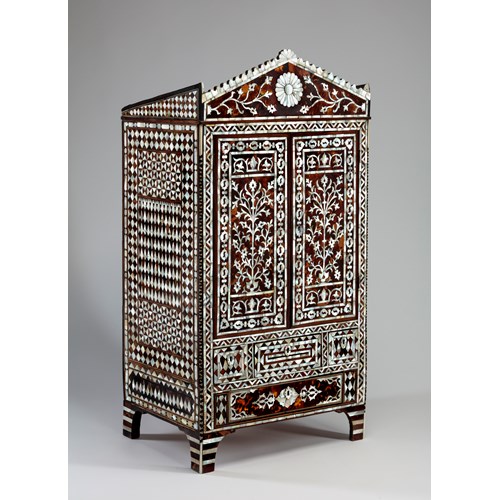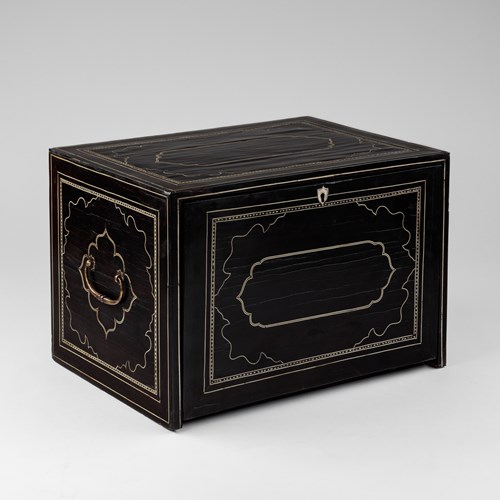A Study of a Bronzed Drongo, Dicrurus aeneus
Date c.1800
Period Early 19th century
Origin Calcutta, India
Medium watercolour on J Whatman paper
Dimension 46.5 x 28 cm (18¹/₄ x 11 inches)
As a family, Drongos are renowned for their aptitude and cunning. Utilising their accomplished skills in mimicry, they reproduce the alarm calls of other species, which are capable of frightening them off and thus causing them to abandon their food. Several drongo species have been witnessed using a variety of different alarm calls in this manner.
Of the 27 species of Drongo in the world, nine are found in India. They frequent the lower Himalayas and the Western and Eastern Ghat mountain ranges. Occupying broadleaf evergreen and deciduous forest, they may be found individually or in small groups. Predominantly insectivorous, they conduct aerial sallies under the forest canopy, searching for insects before returning to a favoured perch. Drongos have also been known to join other species to create larger foraging flocks.
Breeding from February to July, bronzed drongos lay up to four pinkish-brown eggs. Nests are constructed from a variety of materials including bamboo leaves, bark and grasses. After a period of thirteen days the chicks are born and fed by both parents. At 24 centimetres, they are one of the smaller members of the Dicruridae family, but despite this they will aggressively defend their broods by attacking much larger birds.
During his travels in the early nineteenth century, Viscount Valentia would have encountered some of the most accomplished artists in India at the time. With extremely fine detailing, rich and diverse pigments and a great likeness to the subject, the present work bears testament to this. Such accurate morphological characteristics imply the artist was working directly from nature. One can only imagine the wonder experienced by Lord Valentia as he laid his eyes upon these birds for the first time, and his sheer excitement upon returning home with an exceptionally accomplished and diverse collection of ornithological paintings.
For additional ornithological studies made for Lord Valentia, see Sotheby’s Sven Gahlin Collection, Lot 36 a drawing of a bustard, and Lot 37 a watercolour of a crow-pheasant, both made for Lord Valentia; Sotheby’s, London, 31 May 2011, The Stuart Cary Welch Collection, Part Two, lot 115; see also Welch 1976, no.26; Welch 1978-I, nos.18a-c.and Leach 1995, no.7.96, pp.760-2. For two bird studies donated by Viscount Valentia to Lord Wellesley, see British Library in London (Wellesley Collection, NHD 29, vol.iv, f.21,27)
Literature
Hazlitt, Gooden & Fox, 1991. Indian Painting for British Patrons, 1770-1860.
Stuart Carey Welch, 1976. Indian Drawings and Painted Sketches.
Linda Leach, 1995. Mughal and Other Indian Paintings from the Chester Beatty Library, London, vol. ii.
Stock no.: A5492
Date: c.1800
Period: Early 19th century
Origin: Calcutta, India
Medium: watercolour on J Whatman paper
Dimension: 46.5 x 28 cm (18¹/₄ x 11 inches)
Provenance: George Annesley, 2nd Earl of Mountnorris and Viscount Valentia (1769-1844), was a passionate amateur naturalist with a particular interest in ornithology. Following a career in the army, he travelled to India in 1802 where, inspired by his encounters with professional botanists and zoologists, he commissioned a number of natural history paintings.
During his four-month residency with Saadat Ali Khan, Nawab of Oudh (r. 1798-1814), the Viscount was much enthused by the ruler’s additions to his ornithological collection; “he sent people into his woods to bring me rare birds and plants; he laid a dawk two hundred miles to bring them down to me in a state of perfection.” (Viscount Valentia, 1809, p. 172.)
In 1803 he stayed with Lord Wellesley (the elder brother of the first Duke of Wellington) and visited his menagerie in Barrackpore, Calcutta. Viscount Valentia gifted Wellesley two bird studies from his collection, now in the British Library, London (see M. Archer, Natural History Drawings in the India Office Library, London, 1962, p. 96). The works bear his personal Indian seal, “The Right Honourable Lord Bahadur Viscount Valentia.”
Returning to England in 1806, the Viscount became a member of parliament and wrote a three- volume series chronicling his travels, Voyages and Travels to India, Ceylon and the Red Sea, Abyssinia and Egypt in 1802-06. Published in 1809, the books were illustrated by his draughtsman and secretary Henry Salt. Continuing his interest in the natural world, Annesley became a member of the Royal Society and subsequently his collection has become the subject of an important series of natural history studies, celebrating India’s rich ecological biodiversity.
Of the current series of paintings, four bear the Viscount’s personal Indian seal, “The Right Honourable Lord Bahadur Viscount Valentia 1217 (1802-3)”, while three others have a seal in exactly the same ink as the works with a personal seal. Considering this and that the paintings display such a great likeness to one another, it is highly probable that they were commissioned by the Viscount and undertaken by the same artists. Drawing upon Mughal traditions of exceptionally intricate detail, rich colouration and masterful observation, Viscount Valentia’s artists successfully united this with European scientific taxonomy; achieving a sense of harmony between the romantic and the rational. Charming, informative and highly decorative, these works are a valuable example of the finest early nineteenth century Indian ornithological painting.
Literature
George, Viscount Valentia, 1809. Voyages and Travels to India, Ceylon and the Red Sea, Abyssinia and Egypt in 1802-06. Volume 1, William Miller, London.
Mildred Archer, 1962. Natural History Drawings in the India Office Library, London.
More artworks from the Gallery





_T638839371494677624.jpg?width=500&height=500&mode=pad&scale=both&qlt=90&format=jpg)



